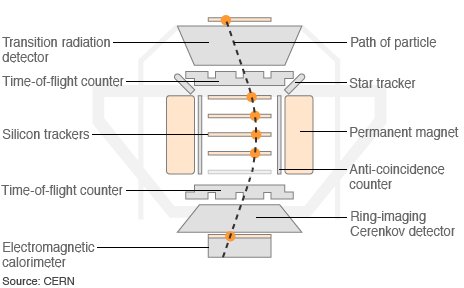The BBC has an excellent article on the Alpha Magnetic Spectrometer (AMS) launched on the second to last shuttle flight to investigate the origins of the universe. NASA’s page is giving regular updates.
What’s nice is that the basic physics of magnetic spectrometers, where magnets are used to deflect the motion of charged particles, should be accessible to middle school students once they get into electricity and magnetism.

Transition Radiation Detector determines highest-energy particle velocities
Silicon Trackers follow particle paths; how they bend reveals their charge
Permanent Magnet is core component of AMS and makes particles curve
Time-of-flight Counters determine lowest-energy particle velocities
Star Trackers scan star fields to establish AMS’s orientation in space
Cerenkov Detector makes accurate velocity measurements of fast particles
Electromagnetic Calorimeter measures energy of impacting particles
Anti-coincidence Counter filters signal from unwanted side particles— Amos (2011): Alpha Magnetic Spectrometer to go on Endeavour shuttle on the BBC.
For additional information, that really gets into the nuts and bolts, you can go CERN’s technical site or get more general info at their public site, which has a wonderful set of videos and animations.